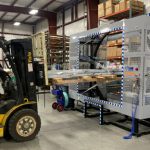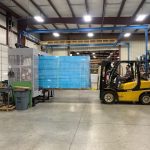Penn Sheet Metal
Sheet Metal Fabricator Eliminates Pallet Wrapping Bottleneck with Automated Orbital Wrapper
Penn Sheet Metal Speeds Packaging, Stops Injuries with TAB Wrapper Tornado
 Business was booming at Penn Sheet Metal, Allentown, PA. From the time President Mike Roeder purchased the metal fabrication company in 2002, revenues grew quickly from $900,000.00 to more than $5 million annually. Product line expansions in architectural and roofing components and custom decorative building products, plus the addition of roll forming and laser cutting services sparked sales. Its stellar reputation for quality parts and products delivered on schedule during a hot market for commercial and residential real estate added more fuel to the growth trajectory.
Business was booming at Penn Sheet Metal, Allentown, PA. From the time President Mike Roeder purchased the metal fabrication company in 2002, revenues grew quickly from $900,000.00 to more than $5 million annually. Product line expansions in architectural and roofing components and custom decorative building products, plus the addition of roll forming and laser cutting services sparked sales. Its stellar reputation for quality parts and products delivered on schedule during a hot market for commercial and residential real estate added more fuel to the growth trajectory.
But as orders surged, a constant bottleneck in the packaging process prevented the company from fully realizing its growth potential, diverted staff away from manufacturing, and threatened its record for on-time deliveries. Approximately 10-15 pallet loads needed to be wrapped and shipped out daily. Since this volume didn’t warrant dedicating specific employees to the packaging process, each of the 20 machinists handled his own packaging. After fabricating or bending an order of downspouts, for example, the machinist would load them onto a custom-built pallet and transport them by forklift to the loading dock for wrapping. Corraling a colleague or two to help, the workers passed a roll of plastic stretch film back and forth by hand, over the metal products and under the pallet while raised on the forklift. This process typically required nearly 15 minutes per pallet load. Sometimes, a single pallet wrap could take a half hour or longer.
Challenges Wrapping Long Products
Given the long lengths and narrow widths of the downspouts, gutters, and the company’s proprietary roof panel system, pallets typically measured an awkward 10 feet x four feet. Its wall panel systems required pallets measuring 16 feet x five feet. Workers were unable to stretch wrap the whole pallet load by hand and had to be content with wrapping only the ends, applying metal banding in several places to compensate for the inconsistent stretch wrapping. Orders rarely suffered from scratches upon arrival but the workers frequently suffered from scratches, cuts, splinters, bashed knuckles, and sore backs incurred during the manual wrapping process.

The steady stream of nagging injuries and the lengthy amount of time required to package orders for delivery gnawed at Roeder. After investing in automated laser cutting, CNC machining centers, press brakes, and other modern equipment to speed production, the decidedly low-tech task of pallet wrapping was hindering overall production speed and capacity. “I always felt there had to be a better way but manual stretch wrapping and banding was standard procedure forever, not just for us, but for almost everyone in the industry,” says Roeder.
“We were wasting so much time wrapping pallets by hand until I’d finally had enough and looked for a solution.”
Orbital Wrapper Secures Parts to Pallets
Turning to the Web, Roeder found an orbital wrapping system called the TAB Wrapper Tornado. Designed and manufactured by TAB Industries, LLC at its Reading, Pennsylvania headquarters, the TAB Wrapper Tornado automatically wraps stretch film 360 degrees around and under the pallet to secure the load to the pallet inside a weather-resistant cocoon and create a sturdy, tight, unitized load that resists shifting in transit.
To operate, a forklift driver centers the pallet load in the wrapping ring and presses the start button on the remote control from inside the cab. The TAB Wrapper Tornado then encircles the pallet and load in stretch wrap as the driver slowly moves forward or back to encase the entire pallet load from end to end in the protective plastic. When complete, the driver presses the stop button, the wrapper’s automated cut and wrap device automatically cuts the end of the plastic, and the driver moves the wrapped pallet onto a truck for delivery, onto a rack for storage, or elsewhere in the plant for temporary staging.
Since the orbital wrapper remains stationary while wrapping around a horizontal axis, elongated pallet loads can be easily wrapped as standard procedure. In fact, theoretically, the TAB Wrapper Tornado can wrap long products up to an infinite length by continuous feeding from a conveyor. Roeder purchased the largest of the standard TAB Wrapper Tornado models, sporting a 100-inch wrapping ring that fits pallet widths of up to five feet, along with the optional wireless automation package that enables the entire wrapping process to be managed without leaving the forklift. The company’s lineup of orbital wrappers offers varying levels of automation based on the required volume and throughput.
Since installing the orbital wrapping machine in March, 2021, Roeder has cut the time required to wrap each pallet from an average of 15 minutes to 60 seconds or less and cut the number of workers involved in the process from two or three to just one worker. This saves an average of 2-1/2 hours per day or more than 78 full, eight-hour workdays per year. After absorbing the retirements of several experienced workers this past year, the automated wrapper has turned any potential productivity losses into dramatic productivity gains, according to Roeder.
The need for banding has been eliminated since the TAB Wrapper Tornado wraps the entire pallet load, front to back, top and bottom. “We’re getting a much better, more secure wrap every time, even on our longest skids and it wouldn’t even be possible to wrap them by hand,” says Roeder, adding that occasional scratches to painted parts have been eliminated and not a single order has been rejected for damage in transit. “I just love this machine!”
Roeder’s 20 employees continue to manage their own packaging, only now they use the TAB Wrapper Tornado for everything that leaves the building. They learned how to safely use the wrapping machine in “literally five or 10 minutes” per Roeder, and the automated packaging process was online and in full operation within 20 minutes of receiving it by flatbed truck. It plugs into standard 240 volt, single phase electrical service and connects to common compressed air lines. “Everyone loves using it and there’s no going back to wrapping by hand,” says Roeder.
Roeder’s customers noticed the change in pallet wrapping and appreciate the upgrade. Now, roofers, builders, and other contractors can transport the pallet loads to the jobsite with ease, quickly identify the proper parts inside the clear, plastic wrap, and keep the parts protected from the elements. “Sometimes we set wrapped pallet loads outside now just because we can,” says Roeder, noting large tarps are no longer needed for deliveries. He’s planning to use stretch wrap from TAB’s own line of film featuring the Penn Sheet Metal logo and branding the next time he orders new rolls for the marketing value.
“The TAB Wrapper Tornado is a solid, well-built machine that has saved us huge amounts of time,” says Roeder. “Anyone wrapping long pallets needs to get it.”
TAB Industries, www.tabwrapper.com
Penn Sheet Metal, www.pennshetmetal.com

